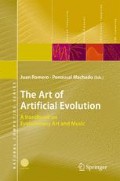Summary
Sound synthesis is a natural domain in which to apply evolutionary computation (EC). The EC concepts of the genome, the phenotype, and the fitness function map naturally to the synthesis concepts of control parameters, output sound, and comparison with a desired sound. More importantly, sound synthesis can be a very unintuitive technique, since changes in input parameters can give rise, via non-linearities and interactions among parameters, to unexpected changes in output sounds. The novice synthesizer user and the simple hill-climbing search algorithm will both fail to produce a desired sound in this context, whereas an EC technique is well-suited to the task.
In this chapter we introduce and provide motivation for the application of EC to sound synthesis, surveying previous work in this area. We focus on the problem of automatically matching a target sound using a given synthesizer. The ability to mimic a given sound can be used in several ways to augment interactive sound synthesis applications. We report on several sets of experiments run to determine the best EC algorithms, parameters, and fitness functions for this problem.
Access this chapter
Tax calculation will be finalised at checkout
Purchases are for personal use only
Preview
Unable to display preview. Download preview PDF.
Reference
Goldberg, D. (1989). Genetic Algorithms in Search, Optimization and Machine Learning. Addison-Wesley. Reading, MA
Grey, J.M. (1976). Multidimensional perceptual scaling of musical timbres. J. Acoust. Soc. Am., 61(5): 1270–1277
McAdams, S., Cunibile, J.C. (1992). Perception of timbral analogies. Philosophical Transactions of the Royal Society, 336(Series B): 383–389
Horner, A., Beauchamp, J., Haken, L. (1993). Machine tongues XVI: Genetic algorithms and their application to FM matching synthesis. Computer Music Journal, 17(4): 17–29
Riionheimo, J., Välimäki, V. (2003). Parameter estimation of a plucked string synthesis model using a genetic algorithm with perceptual fitness calculation. EURASIP Journal on Applied Signal Processing, 8: 791–805
Koza, J.R. (1992). Genetic Programming: On the Programming of Computers by Means of Natural Selection. MIT Press
Wehn, K. (1998). Using ideas from natural selection to evolve synthesized sounds. In: Digital Audio Effects (DAFX)
Garcia, R.A. (2001). Growing sound synthesizers using evolutionary methods. In Bilotta, E., Miranda, E.R., Pantano, P., Todd, P., eds.: Proceedings ALMMA 2001: Artificial Life Models for Musical Applications Workshop (ECAL 2001)
Mitchell, T.J., Pipe, A.G. (2005). Convergence synthesis of dynamic frequency modulation tones using an evolution strategy. In Rothlauf, F., et al., eds.: EvoWorkshops 2005. Berlin Heidelberg. Springer, 533–538
Bolton, S. (2005). XSynth-DSSI. http://dssi.sourceforge.net/ Last viewed 2 March 2006.
Jensen, K. (1999). Timbre Models of Musical Sounds. PhD thesis. Dept. of Computer Science, University of Copenhagen
Eronen, A., Klapuri, A. (2000). Musical instrument recognition using cepstral coefficients and temporal features. In: Proceedings of the 2000 IEEE International Conference on Acoustics, Speech, and Signal Processing. IEEE, 753–756
Lu, L., Zhang, H.J., Jiang, H. (2002). Content analysis for audio classification and segmentation. IEEE Transactions on Speech and Audio Processing, 10(7): 504–516
McDermott, J., Griffith, N.J., O’Neill, M. (2006). Timbral, perceptual, and statistical attributes for synthesized sound. In: Proceedings of the International Computer Music Conference 2006. International Computer Music Association
Luthman, L. (2005). Sineshaper. http://ll-plugins.sourceforge.net Last viewed 1 September 2006.
McDermott, J., Griffith, N.J., O’Neill, M. (2005). Toward user-directed evolution of sound synthesis parameters. In Rothlauf, F., et al., eds.: EvoWorkshops 2005. Berlin. Springer
Jones, T., Forrest, S. (1995). Fitness distance correlation as a measure of problem difficulty for genetic algorithms. In: Proceedings of the 6th International Conference on Genetic Algorithms. San Francisco, CA, USA. Morgan Kaufmann Publishers Inc., 184–192
Gustafson, S.M., Hsu, W.H. (2001). Layered learning in genetic programming for a cooperative robot soccer problem. In Miller, J.F., Tomassini, M., Lanzi, P.L., Ryan, C., Tettamanzi, A., Langdon, W.B., eds.: Proceedings of EuroGP 2001. Springer, 291–301
Johnson, C.G. (2003). Exploring sound-space with interactive genetic algorithms. Leonardo, 36(1): 51–54
Mandelis, J. (2001). Genophone: An evolutionary approach to sound synthesis and performance. In Bilotta, E., Miranda, E.R., Pantano, P., Todd, P., eds.: Proceedings ALMMA 2001: Artificial Life Models for Musical Applications Workshop
Dahlstedt, P. (2001). Creating and exploring huge parameter spaces: Interactive evolution as a tool for sound generation. In: Proceedings of the International Computer Music Conference 2001
Author information
Authors and Affiliations
Editor information
Editors and Affiliations
Rights and permissions
Copyright information
© 2008 Springer-Verlag Berlin Heidelberg
About this chapter
Cite this chapter
McDermott, J., Griffith, N.J.L., O’Neill, M. (2008). Evolutionary Computation Applied to Sound Synthesis. In: Romero, J., Machado, P. (eds) The Art of Artificial Evolution. Natural Computing Series. Springer, Berlin, Heidelberg. https://doi.org/10.1007/978-3-540-72877-1_4
Download citation
DOI: https://doi.org/10.1007/978-3-540-72877-1_4
Publisher Name: Springer, Berlin, Heidelberg
Print ISBN: 978-3-540-72876-4
Online ISBN: 978-3-540-72877-1
eBook Packages: Computer ScienceComputer Science (R0)

